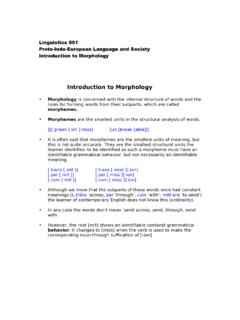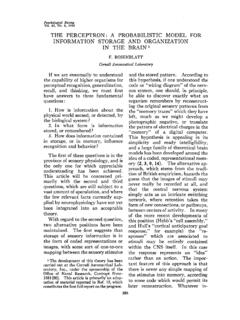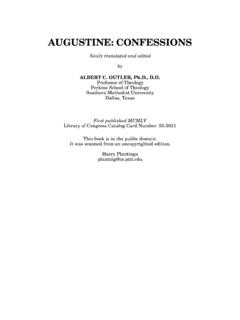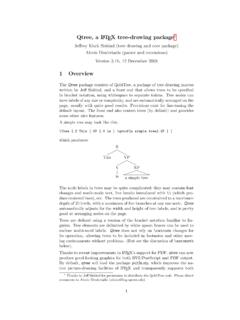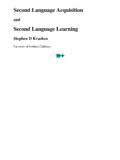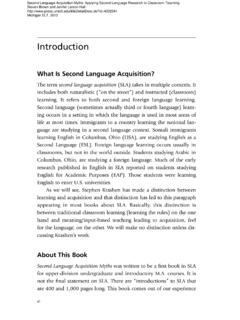Transcription of The Study of Language and Language Acquisition
1 1 The Study of Language andLanguage AcquisitionWe may regard Language as a natural phenomenon anaspect of his biological nature, to be studied in the samemanner as, for instance, his H. Lenneberg, Biological Foundations of Language ( ), p. naturalistic approach to languageFundamental to modern linguistics is the view that humanlanguage is a natural object: our species-specific ability to acquirea Language , our tacit knowledge of the enormous complexity oflanguage, and our capacity to use Language in free, appropriate,and infinite ways are attributed to a property of the natural world,our brain. This position needs no defense, if one considers thestudy of Language is an empirical follows, then, as in the Study of biological sciences, linguisticsaims to identify the abstract properties of the biological objectunder Study human Language and the mechanisms thatgovern its organization.
2 This has the goal set in the earliest state-ments on modern linguistics, Chomsky s The Logical Structure ofLinguistic Theory( ). Consider the famous duo:( ) green ideas sleep *Furiously sleep ideas green sentence has even a remote chance of being encounteredin natural discourse, yet every speaker of English can perceive theirdifferences: while they are both meaningless, ( a) is grammaticallywell formed, whereas ( b) is not. To understand what preciselythis difference is is to give a rational account of this behavior, ,a theory of the speaker s linguistic intuition .. the goal oflinguistic theory (Chomsky / : ) in other words, apsychology, and ultimately, biology of human this position lately dubbed the biolinguisticapproach(Jenkins , Chomsky ) is accepted, it follows thatlanguage, just like all other biological objects, ought to be studiedfollowing the standard methodology in natural sciences (Chomsky , , , a).
3 The postulation of innate linguistic knowl-edge, the Universal Grammar (UG), is a case in of the major motivations for innateness of linguisticknowledge comes from the Argument from the Poverty ofStimulus (APS) (Chomsky, : ). A well-known exampleconcerns the structure dependencyin Language syntax and chil-dren s knowledge of it in the absence of learning experience(Chomsky , Crain & Nakayama ). Forming an interroga-tive question in English involves inversion of the auxiliary verband the subject:( ) Alex esinging a song?b. Has Robin efinished reading?It is important to realize that exposure to such sentences under-determines the correct operation for question formation.
4 Thereare many possible hypotheses compatible with the languageacquisition data in ( ):( ) the first auxiliary verb in the sentenceb. front the auxiliary verb that most closely follows a the last auxiliary verbd. front the auxiliary verb whose position in the sentence is a .. The correct operation for question formation is, of course, struc-ture-dependent: it involves parsing the sentence into structurallyorganized phrases, and fronting the auxiliary that follows the firstnoun phrase, which can be arbitrarily long: Language Acquisition ( ) [NPthe woman who is sing] ehappy?b. Has [NPthe man that is reading a book] ehad supper?
5 Hypothesis ( a), which arguably involves simpler mental compu-tation than the correct generalization, yields erroneous predic-tions:( ) a.*Is [the woman who esinging] is happy?b. *Has [the man that efinished reading] has finished supper?But children don t go astray like the creative inductive learner in( ). They stick to the correct operation from very early on, asCrain & Nakayama ( ) showed using elicitation tasks. Thechildren were instructed, Ask Jabba if the boy who is watchingMickey Mouse is happy , and no error of the form in ( ) sentences like those in ( ) may serve to disconfirmhypothesis ( a), they are very rarely if ever encountered by chil-dren in normal discourse, not to mention the fact that each ofthe other incorrect hypotheses in ( ) will need to be ruled out bydisconfirming evidence.
6 Here lies the logic of the APS: if weknow X, and X is underdetermined by learning experience, thenX must be innate. The conclusion is then Chomsky s ( : ): the child s mind .. contains the instruction: Construct a struc-ture-dependent rule, ignoring all structure-independent principle of structure-dependence is not learned, but formspart of the conditions for Language learning. The naturalistic approach can also be seen in the evolution oflinguistic theories through successive refinement and revision ofideas as their conceptual and empirical flaws are revealed. Forexample, the s Language -particular and construction-specifictransformational rules, while descriptively powerful, are inade-quate when viewed in a biological context.
7 The complexity andLanguage Acquisition In section . , we will rely on corpus statistics from Legate ( ) and Legate &Yang (in press) to make this remark precise, and to address some recent challenges tothe APS by Sampson ( ) and Pullum ( ). See Crain ( ) for several similar cases, and numerous others in the childlanguage of rules made the Acquisition of Language wildlydifficult: the learner had a vast (and perhaps an infinite) space ofhypotheses to entertain. The search for a plausible theory oflanguage Acquisition , coupled with comparative linguistic studies,led to the Principles and Parameters (P&P) framework (Chomsky ), which suggests that all languages obey a universal (andputatively innate) set of tightly constrained principles, whereasvariations across constructions and particular languages thechoices that a child learner has to make during Language acquisi-tion are attributed to a small number of parametric present book is a Study of Language development in chil-dren.
8 From a biological perspective, the development of Language ,like the development of other organic systems, is an interactionbetween internal and external factors; specifically, between thechild s internal knowledge of linguistic structures and the externallinguistic experience he receives. Drawing insights from the studyof biological evolution, we will put forth a model that make thisinteraction precise, by embedding a theory of knowledge, theUniversal Grammar (UG), into a theory of learning from data. Inparticular, we propose that Language Acquisition be modeled as apopulation of grammars , competing to match the external linguis-tic experiences, much in the manner of natural selection.
9 The justi-fication of this approach will take the naturalistic approach just asin the justification of innate linguistic knowledge: we will provideevidence conceptual, mathematical, and empirical, and from anumber of independent areas of linguistic research, including theacquisition of syntax, the Acquisition of phonology, and historicallanguage change to show that without the postulated model, anadequate explanation of these empirical cases is not before we dive into details, some methodological remarkson the Study of Language structure of Language Acquisition At the most abstract level, Language Acquisition can be modeled asbelow: Language Acquisition ( )L.
10 (S , E) STA learning function or algorithm Lmaps the initial state of thelearner,S , to the terminal state ST, on the basis of experience Ein the environment. Language Acquisition research attempts togive an explicit account of this sufficiencyThe Acquisition model must be causaland concrete. Explanationof Language Acquisition is not complete with a mere descriptionof child Language , no matter how accurate or insightful, withoutan explicit account of the mechanism responsible for howlanguage develops over time, the learning function L. It is oftenclaimed in the literature that children just pick up their Language ,or that children s linguistic competence is identical to adults.

